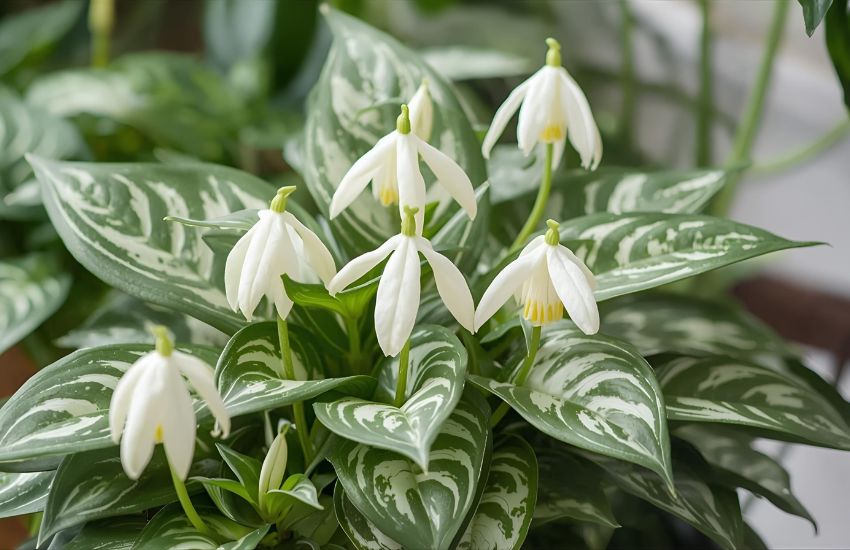Are you looking for an easy-to-care houseplant that brings delicate beauty into your home? The white butterfly plant, also known as Syngonium podophyllum, is an excellent choice. With its elegant, pale-green foliage brushed in creamy white, this butterfly plant—a popular variety of arrowhead vine—adds a calming presence to any indoor space. As a white butterfly arrowhead plant, it not only looks charming but also fits perfectly in modern décor and smaller spaces.
The Syngonium White Butterfly, a charming arrowhead houseplant, thrives in bright, indirect light and well-draining soil. Water when the topsoil feels dry to the touch, and maintain moderate humidity for lush growth. Native to Central and South America, this semi-tropical, evergreen plant is perfect for modern indoor spaces. Rotate regularly for even growth.
In this guide, you’ll discover practical and insightful general care tips—from choosing the right potting mix to propagating from a cutting. Learn how to keep the foliage lush and evenly moist for long-lasting growth. Let’s explore every detail you need to confidently grow and care for your white butterfly plant.
How to Repot, Prune, and Propagate Syngonium White Butterfly Plant

Caring for the Syngonium White Butterfly involves a few essential maintenance practices that help the plant thrive indoors. As a member of the arrowhead vine family, this nephthytis cultivar is a perennial climber with arrow-shaped leaves that resemble butterfly wings. To ensure healthy growth, you must understand when and how to repot, prune, and propagate it correctly.
Repotting Your Syngonium White Butterfly
Repotting is typically required every 1–2 years, especially when the plant grows beyond its current container or becomes root-bound. Choose a well-drained potting mix rich in organic matter, such as a blend of peat, perlite, and compost. Ensure the pot has drainage holes to prevent waterlogging, as this plant prefers evenly moist soils but is sensitive to soggy roots.
Use a slightly larger pot and gently loosen the stem and roots before transferring. Always wear gloves when handling this plant, as it is mildly toxic and can cause skin irritation.
Place the freshly potted plant in a space with bright indirect light, and avoid exposure to direct sunlight, which can scorch the leaves. Maintain room temperature for optimal recovery post-repotting.
Pruning for Shape and Health
Regular pruning during the growing season helps maintain the plant’s compact form and encourages fuller foliage. Remove yellowing or damaged leaves and trim back leggy vines to stimulate new growth. Use clean, sharp scissors and wear gloves when handling, especially if you have sensitive skin.
Pruning also allows you to control the size of your Syngonium White Butterfly, making it suitable for small indoor spaces.
Propagation Made Simple
Propagation is best done through stem cuttings during spring or early summer. Select a healthy stem with at least one node and cut just below it. Place the cutting in water or moist soil, ensuring the node is submerged or covered. Keep the container in bright indirect light, and change the water every few days if water-propagating.
Once roots are established, transfer the cutting into well-drained, fertile soil with good drainage and continue regular waterings to support young growth.
Conclusion
The Syngonium White Butterfly, belonging to the arrowhead vine family and native to Central and South America, is an evergreen, semi-tropical houseplant that brings charm and natural elegance to your indoor decor. With proper care—including mindful pruning, strategic repotting, and propagation from a healthy node—this plant remains both beautiful and vibrant throughout the year.
To support its growth, use all-purpose potting soil, keep humidity levels high, and water when the top layer feels dry to the touch. Avoid letting the soil dry out completely, especially during the summer months. Wipe the leaves regularly with a damp cloth to maintain their health and shine.
Because it contains calcium oxalate, the plant is toxic if ingested and may cause difficulty swallowing or skin irritation from its sap, so it’s best to handle with care. Always keep it out of reach of children and pets.
You may identify a new growth shoot near a node to begin propagation, as the plant is easily propagated. Use a trellis for support if desired, and apply houseplant fertilizer during active growth if you need to fertilize.
Frequently Asked Questions (Syngonium White Butterfly Plant Care Guide for a Charming Arrowhead Houseplant )
How do you take care of a white butterfly arrowhead plant?
The White Butterfly Arrowhead plant thrives in bright, indirect light but tolerates low light. Keep the soil consistently moist, watering when the top inch dries, and ensure good drainage. Maintain high humidity and temperatures between 60–75°F. Wipe leaves to prevent dust, and fertilize monthly in spring and summer for healthy growth and vibrant foliage.
How often should I water a syngonium white butterfly?
Water your Syngonium White Butterfly when the top 1–2 inches of soil feel dry. Typically, this means watering once a week in spring and summer, and less frequently in fall and winter. Avoid overwatering, as soggy soil can cause root rot. Ensure good drainage and adjust watering based on humidity and indoor conditions.
How to care for a syngonium arrowhead plant?
Care for a Syngonium arrowhead plant by placing it in bright, indirect light and keeping the soil consistently moist but not soggy. Water when the top inch feels dry. Maintain moderate humidity and temperatures between 18–27°C. Fertilize monthly during the growing season. Prune regularly to control shape and encourage bushier growth.
Does Syngonium plant need direct sunlight?
Syngonium plants do not need direct sunlight; in fact, harsh sun can scorch their delicate leaves. They thrive best in bright, indirect light but can also tolerate low-light conditions. Placing them near a north or east-facing window works well. Ensure filtered light for vibrant growth and to maintain their attractive leaf patterns without damage.
